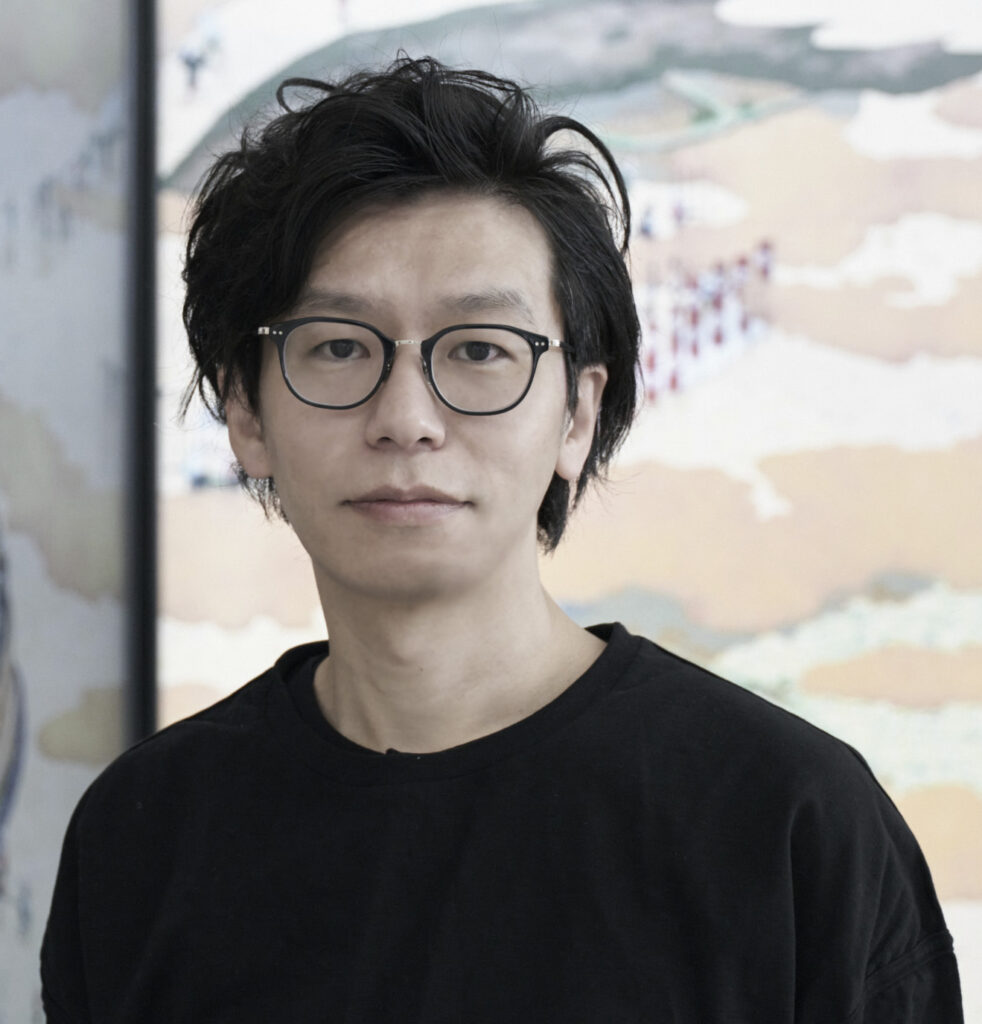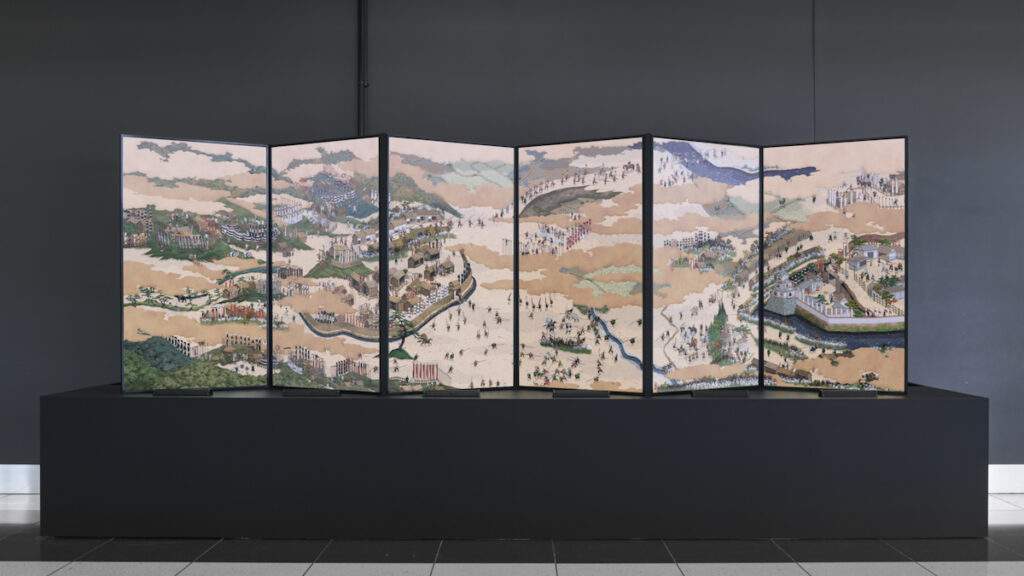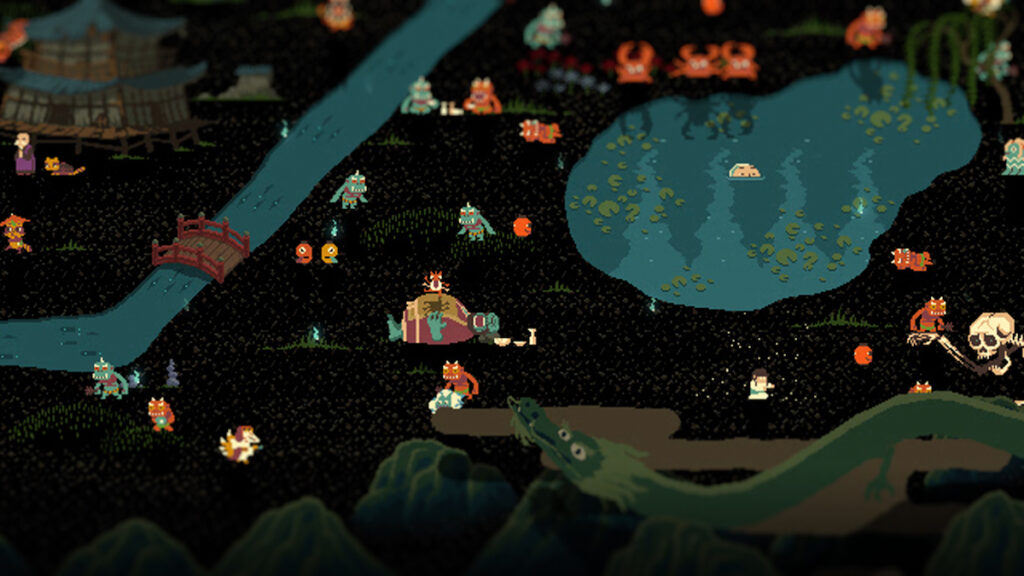Pau Waelder

Japanese videographer Yusuke Shigeta (1981) has developed a body of work consisting of screen-based and multimedia installations for art exhibitions and museum shows. A Graduate from the Tokyo Graduate School of Film and New Media, he works in animation and has recently become involved in the NFT market, where he finds an additional channel of distribution for his work.
His animations are characterized by the exploration of pixel art, with the depiction of complex scenes in the style of low-resolution graphics that became popular with video games in the 1980s. Far from simply using an aesthetic that has been revived in opposition to the dominance of hyperrealism in digital imagery, Shigeta explores pixel art as a form of finding new visual experiences in a world saturated with images. He connects this digital technique with the history of image-making, reinterpreting traditional Japanese paintings in painstakingly detailed animations (despite their pixelated look) that are as imaginative as they are respectful to the source material.
The artist recently presented on Niio a selection of his latest work under the title Pixel Landscapes. In this exclusive interview, he explains his interest in pixel art, traditional painting, and cultural influences in our globalized society.
Discover Yusuke Shigeta’s pixel landscapes
Yusuke Shigeta. Tatsuta Road Kamenose Picture Scroll -龍田古道亀の瀬絵巻-, 2023
You have expressed your interest in working with pixel art from your memories playing with the Nintendo Entertainment System (popularly known as Famicom) in the 1980s. Would you say that the pixelated graphics from this time gave more room to imagination than current high resolution 3D graphics?
I was indeed born in 1980, and I belong to a generation that was greatly influenced by the Nintendo Family Computer (Famicom) during my childhood. Many pixel art artists also have a background in gaming. However, I personally didn’t have a particularly strong interest in games. Of course, I consider games to be a highly influential and significant cultural medium in the present era of expression. Nevertheless, the reason I started creating pixel art was merely a coincidental choice while experimenting with various artistic techniques.
I hold great respect for the pixel techniques nurtured within gaming culture and have learned a lot from producing pixel art. However, I see my work as reconstructing pixel art in a context distinct from games, expanding it into new forms of expression.
Considering the nature of expression, I believe it’s crucial to think about the differences between 3D computer graphics (3DCG) and pixel art. Much of 3DCG aims to replicate photographic techniques and, more fundamentally, the functioning of the retina. On the other hand, pixel art is closer to primitive paintings or symbols. The 20th century witnessed an exploration of optical visual experiences through photography, cinema, and 3DCG, but now we are starting to feel a sense of stagnation. I believe that alternative visual expressions can provide us with new possibilities for visual experiences.
“After photography, cinema, and 3D, we are now starting to feel a sense of stagnation. I believe that alternative visual expressions can provide us with new possibilities for visual experiences.”
It is commonly said that pixel art is “cute.” Would you say it is cute because it is imperfect? How does this “cuteness” come into play in your work, for instance when depicting a historic battle or a scene from daily life?
I believe the reason for the “cuteness” of pixel art lies in its “sense of size.” Pixel art feels cute because it appears small. However, this is quite peculiar because digital images do not possess a physical size. Whether an image is considered large or small depends on its content. A whale would be considered large, while an ant would be considered small. So why does pixel art evoke a sense of smallness?
I think it’s because of the lack of detail. When humans create something very small, the size of the tools or hands comes into play, inevitably resulting in less intricate details. Therefore, when we encounter pixel art with reduced detail, we intuitively perceive it as something small. Although pixel art is a pure digital form, we perceive a sense of materiality in it. That’s why I believe pieces like my Sekigahara-Sansui-zu-Byobu exude a kind of exquisite beauty akin to delicate craftsmanship.
“Pixel art feels cute because it appears small. However, digital images do not possess a physical size.”
In your pixel art animations based on traditional Japanese paintings, how much do you replicate from an original composition and how much do you create on your own? Do you feel constrained by the traditional norms of composition or does the use of pixel art liberate you to create according to your own rules?
When basing my artwork on traditional Japanese paintings, I adjust the layout to fit the screen, add elements, and sometimes make minor edits. However, my primary objective is to faithfully and modernly reinterpret the original artwork. Beyond the artwork itself, I gather various literature to research the historical background, actual landscapes, and surrounding ideologies of the depicted era. As Japanese people, we modernized significantly through Westernization, becoming an advanced nation. Therefore, exploring the Eastern classical way of thinking in the present offers a rather fresh experience.

There is creativity involved in translating traditional art into pixel art from a technical perspective, but there is also the fascination of rediscovering lost Eastern ideologies and interpreting them in a contemporary context. I am of the opinion that engaging with Eastern classics through my creative work is a highly stimulating process, providing me with numerous insights and ideas. Furthermore, I believe it enriches the viewer’s experience by establishing a connection between the viewer and classical art.
“In Japan, we modernized significantly through Westernization. Therefore, exploring the Eastern classical way of thinking in the present offers a rather fresh experience.”
The Tatsuta Road animation was created for the Kashiwara City History Museum. Can you tell me a bit more about this commission? How does the pixel art reinterpretation of traditional painted scrolls bring the history and aesthetics of this art form closer to a present day audience?
This artwork is in a traditional Japanese painting style, but there were no original illustrations available. It was created based on partial illustrations and texts, with supervision from history experts.
In the modern world, academic disciplines have become specialized and fragmented, but originally, knowledge was a comprehensive system. While specialization is unavoidable for the precision of academic pursuits, I find this approach somewhat restrictive. Personally, I appreciate the old notion of comprehensive knowledge, where different fields stimulate each other. Aesthetics, in particular, has the potential to connect various disciplines and can provide us with new inspirations.
Yusuke Shigeta. Sekigahara-Sansui-zu-Byobu -関ケ原山水図屏風-, 2021
Sekigahara-Sansui-zu-Byobu is exhibited as a “folding screen” made of several digital screens. With its combination of history and traditional and digital art making techniques, it seems a perfect embodiment of Japanese culture. Can you tell me more about this work and how it has been received? Was it challenging to reproduce the original work, applying crowd simulation techniques?
Sekigahara-Sansui-zu-Byobu is currently on permanent display at the Sekigahara Battlefield Memorial Museum. Until 2022, Japan hosted an international media art event called the “Agency for Cultural Affairs Media Arts Festival,” where my work received recognition. This led me to join the “CULTURE GATE to JAPAN” cultural promotion project. In 2021, several media artists were invited to create works based on the traditional cultures of different regions in Japan, with the plan to exhibit these works at Japanese international airports to connect with inbound tourists. Unfortunately, the project couldn’t fully achieve its goals due to the pandemic’s impact. However, “Sekigahara-Sansui-zu-Byobu” received significant attention from both domestic and international audiences, especially through social media. The creation of the “Tatsuta Road Kamenose Picture Scroll” was inspired by the Sekigahara article, and currently, I am working on another “Sekigahara-Byobu” commissioned by the Sekigahara Battlefield Memorial Museum.
Furthermore, in this artwork, I used HOUDINI software for crowd simulation, employing it in an entirely unprecedented manner, which gained recognition at HOUDINI conferences and SIGGRAPH. Collaborating with a specialized team, who are also a collective of media artists, was essential for the production using HOUDINI. The background for this connection can be traced back to the “JAPAN MEDIA ARTS FESTIVAL” mentioned at the beginning.
Yusuke Shigeta. A Shore A.M./ P.M., 2021
A Shore AM/PM is a totally different type of animation that focuses on daily life in the present day and the passing of time. Can you tell me how this work came to be and how you chose the setting and the scenes that are part of it?
A Shore A.M./P.M. is a series depicting the landscapes of the town where I live. I have been living here for almost 10 years and have always wanted to create pixel art of this place because I truly love it. However, most of my previous art presentations were in physical spaces such as galleries and museums, and I ended up producing many large-scale installation works. Amidst this, the pandemic emerged, leading to the cancellation of many exhibitions that relied on in-person interactions. Simultaneously, the rise of NFTs prompted me to start working on a series of animation pieces focused on online showcasing.
In this artwork, I experimented with pixel art techniques that involve depicting familiar landscapes, creating variations with changes in time, and utilizing multiple resolutions while maintaining the same composition. It was intriguing to see the reactions on social media, where many people recognized the scenes as their own town. Some even connected with distant memories they had forgotten. The abstracted pixel art has the power to evoke the landscapes of the viewers’ own memories.
“The abstracted pixel art has the power to evoke the landscapes of the viewers’ own memories.”
Your work often involves installations with large projections, immersive environments and playful interactions with visitors. How do you conceive your work in terms of the space and of the interaction with viewers?
Many video works incorporate a temporal development known as “exposition, rising action, climax, and resolution.” However, when these works are projected in exhibition spaces, the narrative design doesn’t always function seamlessly. This is because many viewers may join in and start watching from different points in the sequence. To address this, I focus on designing the overall temporal experience of the artwork. Sometimes, I embed various playful elements within looped videos or include gradual unfolding of events. As the progression of the experience depends on the viewers themselves, I believe creating artworks that actively engage the audience is crucial. In that regard, pixel art with its “cuteness” and “room for imagination” proves to be highly effective in accomplishing this goal.

Your screen-based work can be presented in large projections, installations, folding digital screens, and also via streaming on any screen now on Niio. What do you think about this flexibility in displaying your work and reaching new audiences?
I studied graphic design in my undergraduate program at university. After that, I joined an animation company and later pursued a graduate program in media arts. Currently, I am involved in various areas, such as pixel art, NFT, and teaching at an oil painting university. I believe this diverse career path truly represents who I am, and I still feel like everything is happening in parallel. I have faith that the new worlds and people I encounter will always provide me with fresh inspiration.
Learn more about Shigeta’s work in this video interview by Toco Toco
